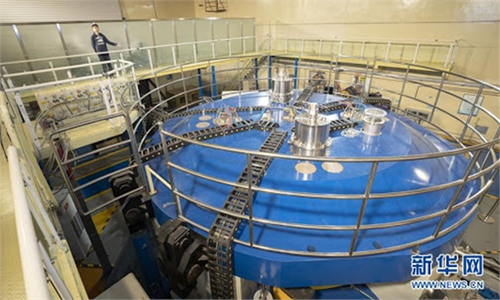
Aerial photo taken on Dec. 1, 2021 shows nuclear power units under the China National Nuclear Corporation (CNNC) in Fuqing, southeast China's Fujian Province.Photo:Xinhua
China's largest seawater uranium extraction test platform has been successfully launched and made accessible to the public in South China's Hainan Province.
The platform, built by China National Nuclear Corporation (CNNC), has a total area of about 670 square meters.
As an important raw material for nuclear power, uranium resources have been described as the "food" of the nuclear industry. Presently, all nuclear fuel utilized in power plants worldwide is obtained through land-based uranium mining.
However, the proven land-based uranium resources, at the current consumption rate, will only last for about 100 years. In contrast, seawater contains approximately 4.5 billion tons of uranium resources, which is nearly 1,000 times more abundant than land reserves.
Given the escalating demand for natural uranium resources and the mounting challenges associated with their extraction, exploring and developing alternative uranium sources, including seawater, has become a strategic imperative to meet China's energy requirements.
For several decades, countries have been striving to develop large-scale technologies for extracting uranium from seawater. While notable research results have emerged in recent years due to the rapid advancement of nuclear power, cost-effective engineering solutions for seawater uranium extraction remain limited, with most research outcomes still confined to laboratory settings.
In November 2019, CNNC initiated an alliance for technological innovation in seawater uranium extraction, collaborating with 14 domestic research institutes. The primary objective of this alliance is to accelerate the engineering application of seawater uranium extraction technology.
Theoretically, seawater uranium extraction technology is expected to be the ultimate guarantee to secure uranium resources. However, the process is akin to finding a needle in a haystack due to the low concentration of uranium in seawater.
Experts noted that the key to seawater uranium extraction technology is the adsorption material. The adsorption capacity of these materials can be significantly impacted by marine pollution, climate conditions, and ocean currents. Consequently, the choice of adsorption materials and the cost of marine engineering are critical factors influencing the economic viability of seawater uranium extraction.
Field tests are a key part of the success of seawater uranium extraction technology. The platform in Hainan has the ability to carry out material verification and amplification experiments under real ocean conditions, and will be open for use by alliance members in the future.
The research and development plan outlined by the seawater uranium extraction technology alliance in China aims to achieve international leadership in this field by 2035. By 2050, their objective is to realize the engineering development and utilization of seawater uranium resources, culminating in the establishment of a large-scale seawater uranium extraction plant.

